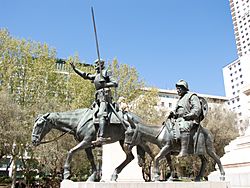Lorenzo Coullaut Valera facts for kids
Lorenzo Coullaut Valera (born in 1876, died in 1932) was a famous Spanish sculptor. He was born in Marchena, Spain. When he was young, his family moved to Nantes, France, where he grew up. He studied at the Livet Lyceum in France. In 1893, he returned to Spain. He continued his art studies in Seville with well-known artists like Antonio Susillo and Agustí Querol Subirats.
Lorenzo Coullaut Valera got help from his uncle, Juan Valera, who was a famous writer. Lorenzo even sculpted a bust (a sculpture of someone's head and shoulders) of his uncle. In 1897, he showed his art at the National Exposition of Belles Artes and received an award called "Honorable Mention." Many of Lorenzo Coullaut Valera's sculptures can be seen in public places. You can find his work in cities all over Spain and even in Latin America. He passed away in Madrid. His son, Federico Coullaut-Valera, also became a sculptor and created many public monuments.
Famous Sculptures
Lorenzo Coullaut Valera created many important sculptures. Here are some of his most well-known works:
- 1913 – A monument for "los Saineteros" (playwrights of short plays) in Madrid.
- 1914 – A monument for Ramón de Campoamor, a Spanish poet, in Madrid.
- 1916 – A monument for Emilia Pardo Bazán, a famous Spanish writer, in A Coruña.
- 1917 – The Monument of Menéndez Pelayo, a Spanish scholar, in Madrid.
- 1918 – A monument of the Immaculate Conception in Plaza del Triunfo, Seville.
- 1926 – A monument for Hosius of Córdoba, an ancient bishop, in Córdoba.
- 1928 – A monument for his uncle, Juan Valera, in Madrid.
- 1930 – The famous monument for Miguel de Cervantes, the writer of Don Quixote, in Madrid.
- 1931 – A monument for Bruno Mauricio de Zabala, a Spanish governor, in Montevideo, Uruguay.
- La Caridad Real (Royal Charity) which is part of a larger monument for Alfonso XII in the Retiro Gardens in Madrid.
See also
 In Spanish: Lorenzo Coullaut Valera para niños
In Spanish: Lorenzo Coullaut Valera para niños


